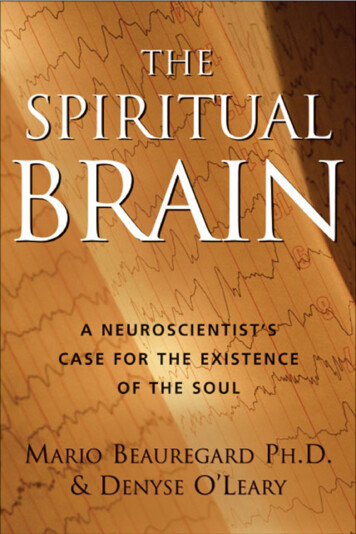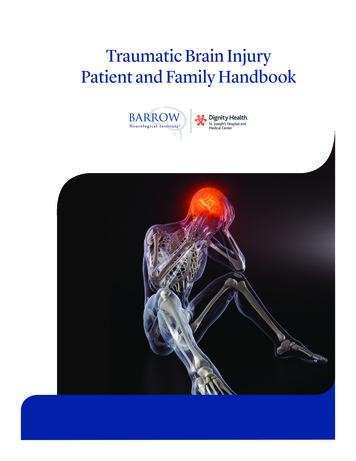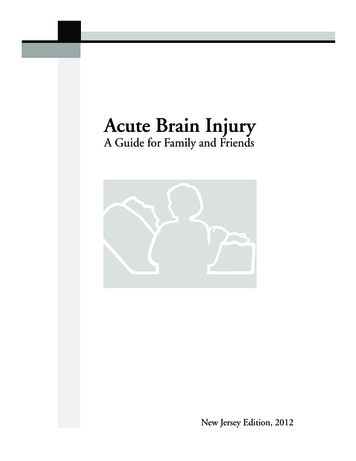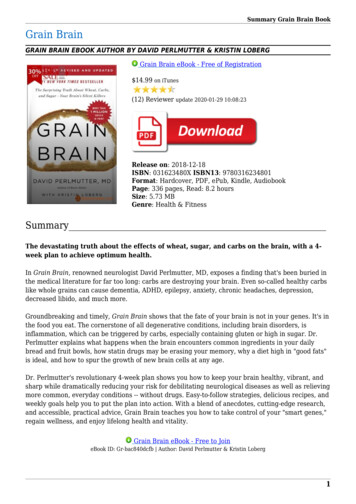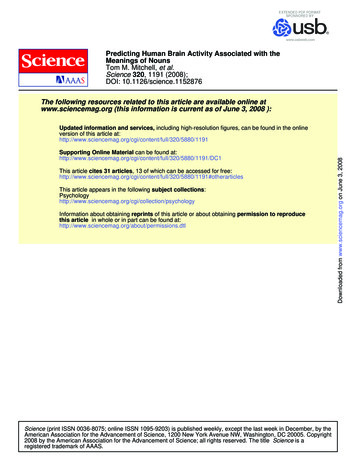
Transcription
Predicting Human Brain Activity Associated with theMeanings of NounsTom M. Mitchell, et al.Science 320, 1191 (2008);DOI: 10.1126/science.1152876The following resources related to this article are available online atwww.sciencemag.org (this information is current as of June 3, 2008 ):Supporting Online Material can be found 5880/1191/DC1This article cites 31 articles, 13 of which can be accessed for 0/5880/1191#otherarticlesThis article appears in the following subject i/collection/psychologyInformation about obtaining reprints of this article or about obtaining permission to reproducethis article in whole or in part can be found Science (print ISSN 0036-8075; online ISSN 1095-9203) is published weekly, except the last week in December, by theAmerican Association for the Advancement of Science, 1200 New York Avenue NW, Washington, DC 20005. Copyright2008 by the American Association for the Advancement of Science; all rights reserved. The title Science is aregistered trademark of AAAS.Downloaded from www.sciencemag.org on June 3, 2008Updated information and services, including high-resolution figures, can be found in the onlineversion of this article 5880/1191
Predicting Human Brain ActivityAssociated with the Meaningsof NounsTom M. Mitchell,1* Svetlana V. Shinkareva,2 Andrew Carlson,1 Kai-Min Chang,3,4Vicente L. Malave,5 Robert A. Mason,3 Marcel Adam Just3The question of how the human brain represents conceptual knowledge has been debated inmany scientific fields. Brain imaging studies have shown that different spatial patterns of neuralactivation are associated with thinking about different semantic categories of pictures andwords (for example, tools, buildings, and animals). We present a computational model that predictsthe functional magnetic resonance imaging (fMRI) neural activation associated with words for whichfMRI data are not yet available. This model is trained with a combination of data from a trillion-wordtext corpus and observed fMRI data associated with viewing several dozen concrete nouns. Oncetrained, the model predicts fMRI activation for thousands of other concrete nouns in the text corpus,with highly significant accuracies over the 60 nouns for which we currently have fMRI data.he question of how the human brain represents and organizes conceptual knowledgehas been studied by many scientific communities. Neuroscientists using brain imaging studies(1–9) have shown that distinct spatial patterns offMRI activity are associated with viewing picturesof certain semantic categories, including tools, buildings, and animals. Linguists have characterized different semantic roles associated with individualverbs, as well as the types of nouns that can fill thosesemantic roles [e.g., VerbNet (10) and WordNet(11, 12)]. Computational linguists have analyzedthe statistics of very large text corpora and havedemonstrated that a word’s meaning is captured tosome extent by the distribution of words and phraseswith which it commonly co-occurs (13–17). Psychologists have studied word meaning throughfeature-norming studies (18) in which participantsare asked to list the features they associate with various words, revealing a consistent set of core features across individuals and suggesting a possiblegrouping of features by sensory-motor modalities.Researchers studying semantic effects of brain damage have found deficits that are specific to givensemantic categories (such as animals) (19–21).This variety of experimental results has led tocompeting theories of how the brain encodes meanings of words and knowledge of objects, includingtheories that meanings are encoded in sensorymotor cortical areas (22, 23) and theories that theyare instead organized by semantic categories suchas living and nonliving objects (18, 24). Althoughthese competing theories sometimes lead to differ-Tent predictions (e.g., of which naming disabilitieswill co-occur in brain-damaged patients), they areprimarily descriptive theories that make no attemptto predict the specific brain activation that will beproduced when a human subject reads a particularword or views a drawing of a particular object.We present a computational model that makesdirectly testable predictions of the fMRI activity associated with thinking about arbitrary concretenouns, including many nouns for which no fMRIdata are currently available. The theory underlyingthis computational model is that the neural basis ofthe semantic representation of concrete nouns isrelated to the distributional properties of those wordsin a broadly based corpus of the language. We describe experiments training competing computational models based on different assumptions regardingthe underlying features that are used in the brainfor encoding of meaning of concrete objects. Wepresent experimental evidence showing that the best*To whom correspondence should be addressed. E-mail:Tom.Mitchell@cs.cmu.edunyv ¼ cvi fi ðwÞi¼1ð1Þwhere fi(w) is the value of the ith intermediatesemantic feature for word w, n is the number ofsemantic features in the model, and cvi is a learnedscalar parameter that specifies the degree to whichthe ith intermediate semantic feature activates voxelv. This equation can be interpreted as predicting thefull fMRI image across all voxels for stimulus wordw as a weighted sum of images, one per semanticfeature fi. These semantic feature images, definedby the learned cvi, constitute a basis set of component images that model the brain activation associated with different semantic components of theinput stimulus words.Predictive modelstimulusword“celery”predictedactivity for“celery”Intermediatesemantic featuresextracted fromtrillion-word textcorpus1Machine Learning Department, School of Computer Science,Carnegie Mellon University, Pittsburgh, PA 15213, USA.2Department of Psychology, University of South Carolina,Columbia, SC 29208, USA. 3Center for Cognitive BrainImaging, Carnegie Mellon University, Pittsburgh, PA 15213,USA. 4Language Technologies Institute, School of ComputerScience, Carnegie Mellon University, Pittsburgh, PA 15213,USA. 5Cognitive Science Department, University of California,San Diego, La Jolla, CA 92093, USA.of these models predicts fMRI neural activity wellenough that it can successfully match words it hasnot yet encountered to their previously unseen fMRIimages, with accuracies far above those expectedby chance. These results establish a direct, predictive relationship between the statistics of wordco-occurrence in text and the neural activationassociated with thinking about word meanings.Approach. We use a trainable computationalmodel that predicts the neural activation for anygiven stimulus word w using a two-step process,illustrated in Fig. 1. Given an arbitrary stimulusword w, the first step encodes the meaning of w asa vector of intermediate semantic features computedfrom the occurrences of stimulus word w within avery large text corpus (25) that captures the typical use of words in English text. For example,one intermediate semantic feature might be thefrequency with which w co-occurs with the verb“hear.” The second step predicts the neural fMRIactivation at every voxel location in the brain, as aweighted sum of neural activations contributed byeach of the intermediate semantic features. Moreprecisely, the predicted activation yv at voxel v inthe brain for word w is given byDownloaded from www.sciencemag.org on June 3, 2008RESEARCH ARTICLESMapping learnedfrom fMRItraining dataFig. 1. Form of the model for predicting fMRI activation for arbitrary noun stimuli. fMRI activationis predicted in a two-step process. The first step encodes the meaning of the input stimulus word interms of intermediate semantic features whose values are extracted from a large corpus of textexhibiting typical word use. The second step predicts the fMRI image as a linear combination of thefMRI signatures associated with each of these intermediate semantic features.www.sciencemag.orgSCIENCEVOL 32030 MAY 20081191
To fully specify a model within this computational modeling framework, one must firstdefine a set of intermediate semantic featuresf1(w) f2(w) fn(w) to be extracted from the textcorpus. In this paper, each intermediate semanticfeature is defined in terms of the co-occurrencestatistics of the input stimulus word w with aparticular other word (e.g., “taste”) or set of words(e.g., “taste,” “tastes,” or “tasted”) within the textcorpus. The model is trained by the application ofmultiple regression to these features fi(w) and theobserved fMRI images, so as to obtain maximumlikelihood estimates for the model parameters cvi(26). Once trained, the computational model can beevaluated by giving it words outside the trainingset and comparing its predicted fMRI images forthese words with observed fMRI data.This computational modeling framework isbased on two key theoretical assumptions. First, itassumes the semantic features that distinguish themeanings of arbitrary concrete nouns are reflectedAPredicted“celery” 0.84in the statistics of their use within a very large textcorpus. This assumption is drawn from the field ofcomputational linguistics, where statistical worddistributions are frequently used to approximatethe meaning of documents and words (14–17).Second, it assumes that the brain activity observedwhen thinking about any concrete noun can bederived as a weighted linear sum of contributionsfrom each of its semantic features. Although thecorrectness of this linearity assumption is debatable, it is consistent with the widespread use oflinear models in fMRI analysis (27) and with theassumption that fMRI activation often reflects alinear superposition of contributions from differentsources. Our theoretical framework does not take aposition on whether the neural activation encodingmeaning is localized in particular cortical regions. Instead, it considers all cortical voxels andallows the training data to determine which locations are systematically modulated by which aspects of word meanings.“eat”“taste”B“fill” 0.35 0.32Results. We evaluated this computational model using f MRI data from nine healthy, college-ageparticipants who viewed 60 different word-picturepairs presented six times each. Anatomically defined regions of interest were automatically labeledaccording to the methodology in (28). The 60 randomly ordered stimuli included five items fromeach of 12 semantic categories (animals, body parts,buildings, building parts, clothing, furniture, insects,kitchen items, tools, vegetables, vehicles, and otherman-made items). A representative f MRI image foreach stimulus was created by computing the meanf MRI response over its six presentations, and themean of all 60 of these representative images wasthen subtracted from each [for details, see (26)].To instantiate our modeling framework, we firstchose a set of intermediate semantic features. To beeffective, the intermediate semantic features mustsimultaneously encode the wide variety of semanticcontent of the input stimulus words and factor theobserved f MRI activation into more primitive com“celery”“airplane” .Predicted:Fig. 2. Predicting fMRI imagesfor given stimulus words. (A)Forming a prediction for participant P1 for the stimulusword “celery” after training on Predicted “celery”:58 other words. Learned cvi coefficients for 3 of the 25 semantic features (“eat,” “taste,”and “fill”) are depicted by thevoxel colors in the three imagesat the top of the panel. The cooccurrence value for each of these features for the stimulus word “celery” isshown to the left of their respective images [e.g., the value for “eat (celery)” is0.84]. The predicted activation for the stimulus word [shown at the bottom of(A)] is a linear combination of the 25 semantic fMRI signatures, weighted bytheir co-occurrence values. This figure shows just one horizontal slice [z AhighObserved:averagebelowaverage–12 mm in Montreal Neurological Institute (MNI) space] of the predictedthree-dimensional image. (B) Predicted and observed fMRI images for“celery” and “airplane” after training that uses 58 other words. The two longred and blue vertical streaks near the top (posterior region) of the predictedand observed images are the left and right fusiform gyri.Fig. 3. Locations ofmost accurately predicted voxels. Surface(A) and glass brain (B)rendering of the correlation between predictedand actual voxel activations for words outsidethe training set for participant P5. These panels show clusters containing at least 10 contiguous voxels, each of whosepredicted-actual correlation is at least 0.28. These voxel clusters are distributed throughout thecortex and located in the left and right occipital and parietal lobes; left and right fusiform,postcentral, and middle frontal gyri; left inferior frontal gyrus; medial frontal gyrus; and anteriorcingulate. (C) Surface rendering of the predicted-actual correlation averaged over all nineparticipants. This panel represents clusters containing at least 10 contiguous voxels, each withaverage correlation of at least 0.14.CMean overparticipantsParticipant P5B119230 MAY 2008VOL 320SCIENCEwww.sciencemag.orgDownloaded from www.sciencemag.org on June 3, 2008RESEARCH ARTICLES
ponents that can be linearly recombined to successfully predict the f MRI activation for arbitrarynew stimuli. Motivated by existing conjectures regarding the centrality of sensory-motor features inneural representations of objects (18, 29), we designed a set of 25 semantic features defined by 25verbs: “see,” “hear,” “listen,” “taste,” “smell,” “eat,”“touch,” “rub,” “lift,” “manipulate,” “run,” “push,”“fill,” “move,” “ride,” “say,” “fear,” “open,” “approach,” “near,” “enter,” “drive,” “wear,” “break,”and “clean.” These verbs generally correspond tobasic sensory and motor activities, actions performed on objects, and actions involving changes tospatial relationships. For each verb, the value of thecorresponding intermediate semantic feature for agiven input stimulus word w is the normalized cooccurrence count of w with any of three forms of theverb (e.g., “taste,” “tastes,” or “tasted”) over the textcorpus. One exception was made for the verb “see.”Its past tense was omitted because “saw” is one ofour 60 stimulus nouns. Normalization consists ofscaling the vector of 25 feature values to unit length.We trained a separate computational model foreach of the nine participants, using this set of 25semantic features. Each trained model was evaluatedby means of a “leave-two-out” cross-validation approach, in which the model was repeatedly trainedwith only 58 of the 60 available word stimuli andassociated fMRI images. Each trained model wastested by requiring that it first predict the fMRIimages for the two “held-out” words and then matchthese correctly to their corresponding held-out fMRIimages. The process of predicting the fMRI imagefor a held-out word is illustrated in Fig. 2A. Thematch between the two predicted and the two observed fMRI images was determined by whichmatch had a higher cosine similarity, evaluated overthe 500 image voxels with the most stableresponses across training presentations (26). Theexpected accuracy in matching the left-out words totheir left-out fMRI images is 0.50 if the model performs at chance levels. An accuracy of 0.62 orhigher for a single model trained for a single participant was determined to be statistically significant(P 0.05) relative to chance, based on the empiricaldistribution of accuracies for randomly generatednull models (26). Similarly, observing an accuracyof 0.62 or higher for each of the nine independently“eat”“push”“run”Fig. 4. Learned voxelactivation signatures for3 of the 25 semantic features, for participant P1(top panels) and averaged ParticipantP1over all nine participants(bottom panels). Just onehorizontal z slice is shownfor each. The semantic feature associated with theverb “eat” predicts substantial activity in rightMean overpars opercularis, which isbelieved to be part of the participantsgustatory cortex. The semantic feature associatedwith “push” activates thePars opercularisPostcentral gyrusSuperior temporalright postcentral gyrus,(z 24 mm)(z 30 mm)sulcus (posterior)which is believed to be(z 12 mm)associated with premotorplanning. The semantic feature for the verb “run” activates the posterior portion of the right superior temporalsulcus, which is believed to be associated with the perception of biological motion.Fig. 5. Accuracies of models basedon alternative intermediate semanticfeature sets. The accuracy of computational models that use 115 different randomly selected sets ofintermediate semantic features isshown in the blue histogram. Eachfeature set is based on 25 wordschosen at random from the 5000most frequent words, excludingthe 500 most frequent words andthe stimulus words. The accuracy ofthe feature set based on manuallychosen sensory-motor verbs is shownin red. The accuracy of each featureset is the average accuracy obtainedwhen it was used to train models foreach of the nine participants.302525 Mean accuracy over nine participantswww.sciencemag.orgSCIENCE0.75VOL 3200.8trained participant-specific models would be statistically significant at P 10 11.The cross-validated accuracies in matching twounseen word stimuli to their unseen fMRI imagesfor models trained on participants P1 through P9were 0.83, 0.76, 0.78, 0.72, 0.78, 0.85, 0.73, 0.68,and 0.82 (mean 0.77). Thus, all nine participantspecific models exhibited accuracies significantlyabove chance levels. The models succeeded in distinguishing pairs of previously unseen words inover three-quarters of the 15,930 cross-validatedtest pairs across these nine participants. Accuracyacross participants was strongly correlated (r –0.66) with estimated head motion (i.e., the less theparticipant’s head motion, the greater the predictionaccuracy), suggesting that the variation in accuracies across participants is explained at least in partby noise due to head motion.Visual inspection of the predicted fMRI imagesproduced by the trained models shows that thesepredicted images frequently capture substantial aspects of brain activation associated with stimuluswords outside the training set. An example is shownin Fig. 2B, where the model was trained on 58 of the60 stimuli for participant P1, omitting “celery” and“airplane.” Although the predicted fMRI images for“celery” and “airplane” are not perfect, they capture substantial components of the activation actually observed for these two stimuli. A plot ofsimilarities between all 60 predicted and observedfMRI images is provided in fig. S3.The model’s predictions are differentially accurate in different brain locations, presumably moreaccurate in those locations involved in encodingthe semantics of the input stimuli. Figure 3 showsthe model’s “accuracy map,” indicating the corticalregions where the model’s predicted activationsfor held-out words best correlate with the observedactivations, both for an individual participant (P5)and averaged over all nine participants. Thesehighest-accuracy voxels are meaningfully distributed across the cortex, with the left hemispheremore strongly represented, appearing in left inferiortemporal, fusiform, motor cortex, intraparietalsulcus, inferior frontal, orbital frontal, and the occipital cortex. This left hemisphere dominance isconsistent with the generally held view that the lefthemisphere plays a larger role than the right hemisphere in semantic representation. High-accuracyvoxels also appear in both hemispheres in the occipital cortex, intraparietal sulcus, and some of theinferior temporal regions, all of which are alsolikely to be involved in visual object processing.It is interesting to consider whether these trainedcomputational models can extrapolate to make accurate predictions for words in new semantic categories beyond those in the training set. To testthis, we retrained the models but this time we excluded from the training set all examples belongingto the same semantic category as either of the twoheld-out test words (e.g., when testing on “celery”versus “airplane,” we removed every food and vehicle stimulus from the training set, training on only50 words). In this case, the cross-validated prediction accuracies were 0.74, 0.69, 0.67, 0.69, 0.64,30 MAY 2008Downloaded from www.sciencemag.org on June 3, 2008RESEARCH ARTICLES1193
0.78, 0.68, 0.64, and 0.78 (mean 0.70). Thisability of the model to extrapolate to words semantically distant from those on which it wastrained suggests that the semantic features andtheir learned neural activation signatures of themodel may span a diverse semantic space.Given that the 60 stimuli are composed of fiveitems in each of 12 semantic categories, it is alsointeresting to determine the degree to which themodel can make accurate predictions even whenthe two held-out test words are from the same category, where the discrimination is likely to be moredifficult (e.g., “celery” versus “corn”). These withincategory prediction accuracies for the nine individuals were 0.61, 0.58, 0.58, 0.72, 0.58, 0.77, 0.58,0.52, and 0.68 (mean 0.62), indicating that although the model’s accuracy is lower when it isdifferentiating between semantically more similarstimuli, on average its predictions neverthelessremain above chance levels.In order to test the ability of the model to distinguish among an even more diverse range ofwords, we tested its ability to resolve among 1000highly frequent words (the 1300 most frequenttokens in the text corpus, omitting the 300 mostfrequent). Specifically, we conducted a leave-oneout test in which the model was trained using 59 ofthe 60 available stimulus words. It was then giventhe fMRI image for the held-out word and a set of1001 candidate words (the 1000 frequent tokens,plus the held-out word). It ranked these 1001candidates by first predicting the fMRI image foreach candidate and then sorting the 1001 candidatesby the similarity between their predicted fMRI image and the fMRI image it was provided. The expected percentile rank of the correct word in thisranked list would be 0.50 if the model were operating at chance. The observed percentile ranksfor the nine participants were 0.79, 0.71, 0.74, 0.67,0.73, 0.77, 0.70, 0.63, and 0.76 (mean 0.72), indicating that the model is to some degree applicable across a semantically diverse set of words[see (26) for details].A second approach to evaluating our computation model, beyond quantitative measurements ofits prediction accuracy, is to examine the learnedbasis set of fMRI signatures for the 25 verb-basedsignatures. These 25 signatures represent the model’slearned decomposition of neural representations intotheir component semantic features and provide thebasis for all of its predictions. The learned signaturesfor the semantic features “eat,” “push,” and “run”are shown in Fig. 4. Notice that each of these signatures predicts activation in multiple cortical regions.Examining the semantic feature signatures inFig. 4, one can see that the learned fMRI signaturefor the semantic feature “eat” predicts strong activation in opercular cortex (as indicated by the arrowsin the left panels), which others have suggested is acomponent of gustatory cortex involved in the senseof taste (30). Also, the learned fMRI signature for“push” predicts substantial activation in the rightpostcentral gyrus, which is widely assumed to beinvolved in the planning of complex, coordinatedmovements (31). Furthermore, the learned signature1194for “run” predicts strong activation in the posteriorportion of the right superior temporal lobe along thesulcus, which others have suggested is involved inperception of biological motion (32, 33). To summarize, these learned signatures cause the model topredict that the neural activity representing a nounwill exhibit activity in gustatory cortex to the degreethat this noun co-occurs with the verb “eat,” in motor areas to the degree that it co-occurs with “push,”and in cortical regions related to body motion to thedegree that it co-occurs with “run.” Whereas thetop row of Fig. 4 illustrates these learned signatures for participant P1, the bottom row shows themean of the nine signatures learned independentlyfor the nine participants. The similarity of the tworows of signatures demonstrates that these learnedintermediate semantic feature signatures exhibitsubstantial commonalities across participants.The learned signatures for several other verbsalso exhibit interesting correspondences betweenthe function of cortical regions in which they predict activation and that verb’s meaning, though insome cases the correspondence holds for only asubset of the nine participants. For example, additional features for participant P1 include the signature for “touch,” which predicts strong activationin somatosensory cortex (right postcentral gyrus),and the signature for “listen,” which predicts activation in language-processing regions (left posteriorsuperior temporal sulcus and left pars triangularis),though these trends are not common to all nineparticipants. The learned feature signatures for all25 semantic features are provided at (26).Given the success of this set of 25 intermediatesemantic features motivated by the conjecture thatthe neural components corresponding to basic semantic properties are related to sensory-motorverbs, it is natural to ask how this set of intermediate semantic features compares with alternatives.To explore this, we trained and tested models basedon randomly generated sets of semantic features,each defined by 25 randomly drawn words from the5000 most frequent words in the text corpus, excluding the 60 stimulus words as well as the 500most frequent words (which contain many functionwords and words without much specific semanticcontent, such as “the” and “have”). A total of 115random feature sets was generated. For each featureset, models were trained for all nine participants, andthe mean prediction accuracy over these ninemodels was measured. The distribution of resultingaccuracies is shown in the blue histogram in Fig. 5.The mean accuracy over these 115 feature sets is0.60, the SD is 0.041, and the minimum and maximum accuracies are 0.46 and 0.68, respectively.The random feature sets generating the highest andlowest accuracy are shown at (26). The fact that themean accuracy is greater than 0.50 suggests thatmany feature sets capture some of the semanticcontent of the 60 stimulus words and some of theregularities in the corresponding brain activation.However, among these 115 feature sets, none cameclose to the 0.77 mean accuracy of our manuallygenerated feature set (shown by the red bar in thehistogram in Fig. 5). This result suggests the set of30 MAY 2008VOL 320SCIENCEfeatures defined by our sensory-motor verbs issomewhat distinctive in capturing regularities in theneural activation encoding the semantic content ofwords in the brain.Discussion. The results reported here establish a direct, predictive relationship between thestatistics of word co-occurrence in text and theneural activation associated with thinking aboutword meanings. Furthermore, the computationalmodels trained to make these predictions provideinsight into how the neural activity that representsobjects can be decomposed into a basis set ofneural activation patterns associated with differentsemantic components of the objects.The success of the specific model, which uses 25sensory-motor verbs (as compared with alternativemodels based on randomly sampled sets of 25semantic features), lends credence to the conjecturethat neural representations of concrete nouns are inpart grounded in sensory-motor features. However,the learned signatures associated with the 25intermediate semantic features also exhibit significant activation in brain areas not directly associatedwith sensory-motor function, including frontal regions. Thus, it appears that the basis set of featuresthat underlie neural representations of concretenouns involves much more than sensory-motorcortical regions.Other recent work has suggested that the neuralencodings that represent concrete objects are at leastpartly shared across individuals, based on evidencethat it is possible to identify which of several items aperson is viewing, through only their fMRI imageand a classifier model trained from other people (34).The results reported here show that the learnedbasis set of semantic features also shares certaincommonalities across individuals and may helpdetermine more directly which factors of neuralrepresentations are similar and different acrossindividuals.Our approach is analogous in some ways to research that focuses on lower-level visual features ofpicture stimuli to analyze fMRI activation associated with viewing the picture (9, 35, 36) and toresearch that compares perceived similarities between object shapes to their similarities based onf MRI activation (37). Recent work (36) has shownthat it is possible to predict aspects of f MRI activation in parts of visual cortex based on visual featuresof arbitrary scenes and to use this predicted activation to identify which of a set of candidate scenes anindividual is viewing. Our work differs from theseefforts, in that we focus on encodings of more abstract semantic concepts signified by words andpredict brain-wide fMRI activations based on textcorpus features that capture semantic aspects of thestimulus word, rather than visual features that captureperceptual aspects. Our work is also related to recentresearch that uses machine learning algorithms totrain classifiers of mental states based on f MRI data(38, 39), though it differs in that our models arecapable of extrapolati
1Machine Learning Department, School of Computer Science, Carnegie Mellon University, Pittsburgh, PA 15213, USA. 2Department of Psychology, University of South Carolina, Columbia, SC 29208, USA. 3Center for Cognitive Brain Imaging, Carnegie Mellon University, Pittsburgh, PA 15213, USA. 4Language Technologies Institute, School of Computer



